Sid Meier's Civilization: The Board Game - A Review.
 Thursday, March 17, 2011 at 12:24AM
Thursday, March 17, 2011 at 12:24AM 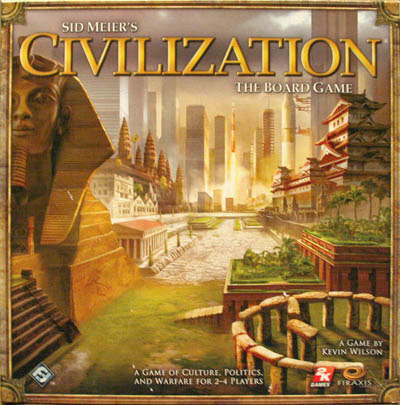
Sid Meier's Civilization: The Board Game is Fantasy Flight's 2010 tabletop take on the popular Video game franchise of the same name. Designed by Kevin Wilson, Sid Meier's Civilization: The Board Game attempts to capture the feel of Sid Meier’s Civilization the video game (which I’ll refer to as Civ from here on out), a game about growing a civilization from humble roots through the use of military might, technological achievement, cultural enrichment, or acquisition of wealth.
Wilson isn’t the first to tackle a board game conversion of the Civ license, but those that have tried before him have failed to really capture the essence of the original. Wilson has experience successfully bridging the gap between the computer and the tabletop with his work on Fantasy Flight’s Warcraft: The Board Game, and Doom: The Board Game. His respect for these games really shows through in his design choices, and the way he smartly approaches the licenses. His work on Sid Meier's Civilization: The Board Game is no different. His design is not a quick attempt at slapping a licensed theme on a preconceived game design, but instead pays homage to the source material, and creates a very engaging board gaming experience.
Civ might seem like an easy target to make the transition to a board game. After all, it had definite roots in the board game medium. Sid Meier, creator of Civ, has expressed that the classic Avalon Hill board game Civilization was a strong influence on the design of Civ. But, inspiration wasn’t the only influence that board games had on the computer game. Sid Meier also employed former Avalon Hill employee Bruce Shelley as an assistant and collaborator when designing Civ. Before joining Meier, Shelly had worked for Avalon Hill bringing games such as 1830 and Titan to market. With such a tie to board games, it is surprising that almost 20 years after Civ was published, Fantasy Flight seems to be the first contender to finally capture the feel of Sid Meier’s Civilization.
Let’s take a closer look at this board game, inspired by a video game, inspired by a board game, and see what makes it tick.
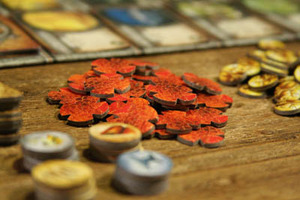 Tokens and counters are all high quality, and wonderfully illustrated.Components:
Tokens and counters are all high quality, and wonderfully illustrated.Components:
In true Fantasy Flight style, the components in Sid Meier's Civilization: The Board Game are wonderful. And, in true Fantasy Flight style, punching out the components will take a while. But, after all of the components have been freed from their cardboard sprues, it becomes apparent that the modular game board and mountain of tokens are all made of high quality cardboard, and covered with beautiful artwork. No one is going to accuse this game of having low production quality.
Sid Meier’s Civilization: The Board Game has a variety of different components:
A market board - The market board holds all of the buildings, units and wonders that can be purchased during the course of the game. It also contains as a scoring track for culture points earned during gameplay. The market board looks nice, and serves as a place to put most of the components in the game. I just wish that it had places for more of the components. While half of the game stays organized with the market board, the table can still get cluttered as the piles of tokens, plastic figures, and cards that don’t have a place on the board can fill the empty table space. Aside from that small detail, the market board is very useful, and nicely illustrated.
Map tiles - Sid Meier’s Civilization: The Board Game uses a modular map to create a new game world each play. The tiles that make up this map are single sided and placed face down at the start of the game. Map tiles are flipped over as areas are explored, recreating the exploration aspect of Civ. Each map tile has different terrain represented on it, and iconography describing what is produced in each area. The terrain and icons are easily distinguishable, and appealing to look at.
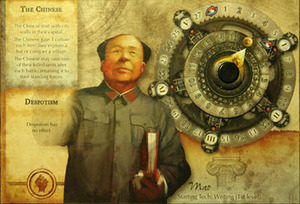 The civilization sheets feature dials similar to those in other Fantasy Flight titles.Civilization sheets - The civilization sheets are cardstock mats that describe the civilization, and list its special abilities, starting government, and starting technology. The civilization sheets also allow the player to manage his available gold and trade using an attached cardboard dial. These dials will be familiar to anyone who has played Runewars, as they are practically identical. The dial is a really novel idea, but I’m always concerned that I will rip the comparatively flimsy cardstock sheet when turning it.
The civilization sheets feature dials similar to those in other Fantasy Flight titles.Civilization sheets - The civilization sheets are cardstock mats that describe the civilization, and list its special abilities, starting government, and starting technology. The civilization sheets also allow the player to manage his available gold and trade using an attached cardboard dial. These dials will be familiar to anyone who has played Runewars, as they are practically identical. The dial is a really novel idea, but I’m always concerned that I will rip the comparatively flimsy cardstock sheet when turning it.
Plastic units - Military Units and scouts are represented by plastic figures in the game. The scouts look like the iconic covered wagon from the Civ games, and the Military units are represented by colored plastic flags. Fantasy Flight is known for their detailed miniatures, and I was a bit disappointed to see that the units were represented as flags. I think this is an area that Fantasy Flight could have upgraded to increase the immersion a bit. I really would have liked to see figures that I could paint.
Cards - Cards are used to represent many things in the game. Combat is resolved through the use of cards, technology and governments a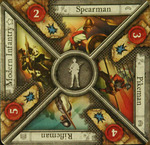 The combat cards can feel a bit cluttered and disorienting.re represented with cards, and events are triggered through cards. The cards are good quality, and serve their purpose well for the most part. However, I do have an issue with the combat cards: the iconography on the cards can be a bit difficult to make out at a glance; the art makes the cards feel cluttered; and the orientation of the cards changes their meaning. The combat cards are my biggest gripe with the game in general, they just seem a bit obtuse to me, and I can’t help but thinking a set of dice would serve the same purpose in a much simpler manner. Perhaps if the combat cards had clearer icons, and didn’t seem so cluttered, I wouldn’t feel as strongly as I do about them.
The combat cards can feel a bit cluttered and disorienting.re represented with cards, and events are triggered through cards. The cards are good quality, and serve their purpose well for the most part. However, I do have an issue with the combat cards: the iconography on the cards can be a bit difficult to make out at a glance; the art makes the cards feel cluttered; and the orientation of the cards changes their meaning. The combat cards are my biggest gripe with the game in general, they just seem a bit obtuse to me, and I can’t help but thinking a set of dice would serve the same purpose in a much simpler manner. Perhaps if the combat cards had clearer icons, and didn’t seem so cluttered, I wouldn’t feel as strongly as I do about them.
Tokens, Tokens, Tokens - Sid Meier’s Civilization: The Board Game uses tokens for everything: cities, buildings, great people, culture, wonders, military tech level, resources, wounds, money, villages, etc. Even though there are a lot of these pieces of cardboard, they all serve a particular purpose and work well at representing what they need to in a clear and direct manner.
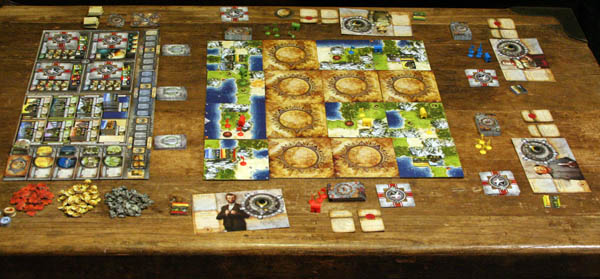
All in all, the components are top notch. My only real criticism was with the combat cards, and that may be more of an issue with the combat mechanism itself.
Gameplay:
Sid Meier’s Civilization: The Board Game is a fairly complex game. Because it stays faithful to the source material, there are multiple paths to victory: Military, Economic, Cultural, and Technological. These multiple victory conditions require a set of rules, and components, for each path.
Players explore, collect resources, settle, and grow their cities striving to be the first to reach the victory condition in one of these victory paths. A cultural victory requires a certain number of culture points to win; a tech victory is awarded to the first person to research "Space Flight"; an economic victory is gained by amassing a certain amount of wealth; and a military victory is won by conquering another player’s capital city.
A player grows his city by purchasing buildings to add to his city. These buildings increase the footprint of his city, and in turn, allow more resources to be generated. Most resources are generalized as "Trade" or "Production", although specific resource types can be collected and produced in 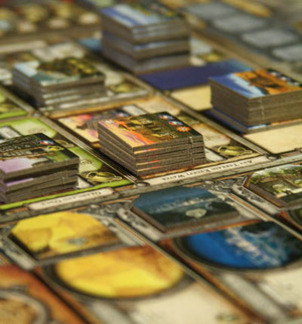 the game as well. The resources that a certain position on the map produces are indicated by the icons on the map tile, and are modified by the building tiles that are placed on top of them. Resources are spent to purchase more buildings, military units, technology, and culture among other things. These newly purchased items add to the power or production of a city, generating a kind of "economic engine" moving the player forward towards his goal.
the game as well. The resources that a certain position on the map produces are indicated by the icons on the map tile, and are modified by the building tiles that are placed on top of them. Resources are spent to purchase more buildings, military units, technology, and culture among other things. These newly purchased items add to the power or production of a city, generating a kind of "economic engine" moving the player forward towards his goal.
There are rules that dictate where players can grow their cities. Due to the way these rules operate, a large part of Sid Meier’s Civilization: The Board Game is about area control. It is beneficial to grow your city before your opponent does, but at the same time, it can leave you vulnerable to attack. Players have to balance their progress towards a victory goal with growth of other aspects of their civilization.
Three of the four victory paths are not directly confrontational in nature. However, like in Civ, military might plays a large role in this game. Combat can be a bit unintuitive at first. There are two representations of the player’s military might: The first is the units on the board, which move to establish the location of the player’s armies; the second is the deck of cards that players maintain to represent the military strength and unit types found in their civilization. The combat cards are more of an abstract representation of the civilization’s military might, as the same deck of cards is shared between all of the armies on the board, and a hand is drawn from that deck when combat begins. Units and cards are purchased separately, creating a bit of a dissonance between the two.
When combat actually occurs, players take turns placing their combat cards along an imaginary "battle front". Each combat card represents a different type of military unit: Infantry, Mounted, and Artillery. These units have a Rock, Paper, Scissors relationship with one another when determining which unit takes damage first. Every card can represent each of the four military tech levels, with the attack value of each level oriented along one of the four sides. This makes it important to keep your cards rotated in the correct direction so that you don’t accidentally make tactical decisions using the wrong number. Each card also has an illustration of the unit type for each milit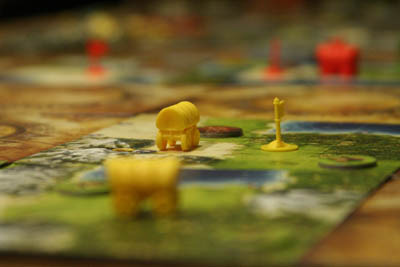 ary tech level, and an icon for the type of unit that card represents. All of this information makes the card feel cluttered, and it can be difficult to glean information from it at a glance.
ary tech level, and an icon for the type of unit that card represents. All of this information makes the card feel cluttered, and it can be difficult to glean information from it at a glance.
Combat is balanced, functional, and fun, but it’s a bit fiddly. I’m not sure that the card mechanic really fits perfectly the way it is. I think a simpler mechanic, or perhaps dice based combat would have kept things running a bit more smoothly, but this small criticism definitely isn’t a deal breaker. I don’t dislike combat in Sid Meier's Civilization: The Board Game, I just wish it was a bit more streamlined.
The game plays well from 2 players to its maximum of 4 players. The different victory conditions are well balanced, and I can see a player making a solid winning strategy using any of the paths. A game of civilization could easily last for 3+ hours; maybe more if the players are new to the game. The instructions suggest removing the "Wonders" for the first game, and I would agree that it creates a slightly easier, yet still fulfilling first game experience.
Conclusion:
Overall, Sid Meier's Civilization: The Board Game does an excellent job of capturing the feel of its video game namesake. It makes a fun, deep strategy board game that could easily stand on its own without the Civ license. It is definitely one of my favorite civilization building board games, and I don’t think I would turn down a game if I had the time and opportunity to play. I’m not totally sold on the card based combat mechanism. However, it is still fun, and doesn’t detract from the game, as it’s just a small part in the larger whole. The game is a bit on the long side, and may be hard to get to the table for people who cannot spare a block of time to play, and, due to the sheer number of components, putting the game away and taking it back out to finish a game becomes unfeasible. For those that love a nice long meaty game, Fantasy Flight’s offering definitely scratches the itch, though.
When all is said and done, Sid Meier's Civilization: The Board Game really gives the feeling of building a civilization from scratch. With all of the different leaders, technologies, and governments available, the strategic combinations are endless. Who can resist reliving a history where Abraham Lincoln of the Communist States of America wages a vicious war against Cleopatra and the money grubbing anarchists of Egypt? I certainly can’t, and I would definitely recommend giving Sid Meier's Civilization: The Board Game a try.
 Board Games,
Board Games,  Civilization,
Civilization,  Fantasy Flight,
Fantasy Flight,  Kevin Wilson,
Kevin Wilson,  review in
review in  Board Games
Board Games 
Reader Comments (1)
Great first post William! Im very interested in trying this game out, its on my wishlist.